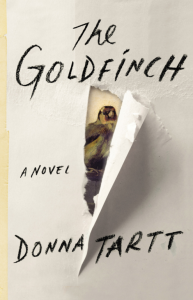By Diego Báez
 Donna Tartt has turned out a single novel every decade, starting with her bestselling debut, The Secret History (1992), a semi-autobiographical “murder mystery in reverse” about students at a small private school in Vermont. The Little Friend (2002) followed and fixes its focus on the suspenseful, Mississippi-based story of 12-year-old Hattie’s extended family and Southern life at large. The Goldfinch (2013) follows thirteen-year-old Theo Decker, who loses his mother when an explosion destroys an entire wing of an art museum in New York City. Theo’s estranged father reappears and absconds with the boy, removing him to the desert wastes of Las Vegas. Over the course of his drawn-out adventure, Theo finds himself inextricably linked to the novel’s eponymous masterpiece and its role in the underground art market.
Donna Tartt has turned out a single novel every decade, starting with her bestselling debut, The Secret History (1992), a semi-autobiographical “murder mystery in reverse” about students at a small private school in Vermont. The Little Friend (2002) followed and fixes its focus on the suspenseful, Mississippi-based story of 12-year-old Hattie’s extended family and Southern life at large. The Goldfinch (2013) follows thirteen-year-old Theo Decker, who loses his mother when an explosion destroys an entire wing of an art museum in New York City. Theo’s estranged father reappears and absconds with the boy, removing him to the desert wastes of Las Vegas. Over the course of his drawn-out adventure, Theo finds himself inextricably linked to the novel’s eponymous masterpiece and its role in the underground art market.
Incredibly well-developed and deeply articulate about his evolving states of mind, Theo’s the latest in a long line of adolescent narrators: he’s bright, but not Incandenza brilliant; a natural mimic like JR Vansant, but lacking a precocious knack for finance; he struggles in private school, like Holden Caulfield, and spends a lot of time meandering Manhattan; he follows an intriguing series of strange clues like Oskar Schell, who likewise lost a parent in a terrorist attack in New York; slowly unravels his role at the center of a complex plot, the exact opposite of messianic narcissist Gurion ben-Judah Maccabee. Theo Decker is your typical 21st– century NYC adolescent, a child of relative privilege, forced to navigate an engrossing series of unusual circumstances with pluck and aplomb.
While the bulk of The Goldfinch’s 700+ pages recounts Theo’s metamorphosis from damaged eighth-grader to canny survivalist (Tartt adds intermittent moments of reflection that hint at Theo’s post facto attitude toward the unfolding events), the mysterious centerpiece and namesake of the novel is a 17th-century painting by Dutch master Carel Fabritius, reportedly one of Rembrandt’s star pupils. Fabritius completed the oil on panel in 1654, shortly before his death at the terrible Delft Thunderclap, an explosion at a gunpowder magazine. (Fellow Dutch artist, Egbert van der Poel, painted views of the smoking devastation over and over, mesmerized by the burning city.) In the opening pages of The Goldfinch, in the disorienting aftermath of the museum attack, Theo attempts to comfort a dying man, who instructs him to save the painting from the wreckage (or “steal,” if you like). It’s one of the book’s most intriguing passages and sets the tone as the plot unfolds.
This passage is also one of the longest, taking Theo the better part of thirty pages to navigate the ruins and rubble of the exhibits, rendered in admittedly precise, page-turning prose. Tartt allows characters to inhabit chapters elongated by lists and stacks of stuff packed into the interiors of garden apartments, appliances, furniture. The resulting detail lends an indispensible intimacy to the characters, but risks disrupting the momentum of the plot. Here’s a sample sentence, plucked from Theo’s layover in Las Vegas, in which he waxes nostalgic about his childhood home:
Xandra’s dog Popper – who lived, for the most part, in a brown plastic igloo on the shady side of the fence – ran back and forth along the side of the pool yapping as I floated on my back, trying to pick out constellations I knew in the confusing white spatter of stars: Lyra, Cassiopeia the queen, whiplash Scorpius with the twin stings in his tail, all the friendly childhood patterns that had twinkled me to sleep from the glow-in-the-dark planetarium stars on my bedroom ceiling back in New York (233).
How central to the story are trivial nods to Popper’s doghouse or “whiplash” constellations? Why the descriptive interjections and extenuating punctuation? What the hell happened to that Fabritius? (At that point, it’s stashed away in Theo’s gym bag, just waiting.) And yet, anyone who enjoys serious immersion in an introspective young person’s perspective will appreciate Tartt’s treatment of what swiveling bewilderment it must be like for a child to lose his mother. Tartt writes realist fiction of a certain, unrushed mode of verisimilitude and scenic depth. Whereas other authors may spend a few paragraphs introducing an amusing Ukrainian sidekick at school, Tartt catalogs all of seventh period English, complete with mini-lesson on Emerson.
While The Goldfinch has drawn comparisons to Dickens—for its focus on young narrators and adverb-heavy inflection—and a lovable, bumbling craftsman called Hobie smacks one ill-read critic of Harry Potter’s Hagrid, and the Latino doormen sound like Agador Spartacus stripped of his defining flamboyance, readers fascinated enough by the complex characters Tartt develops will enjoy the novel’s eventual winding resolution. The Goldfinch is a book to relax and enjoy and, if you’re into it, dive into the rest of this selective author’s expertly-crafted oeuvre.
The Goldfinch
By Donna Tartt
Little, Brown and Company (October 22, 2013)
978-0316055437
